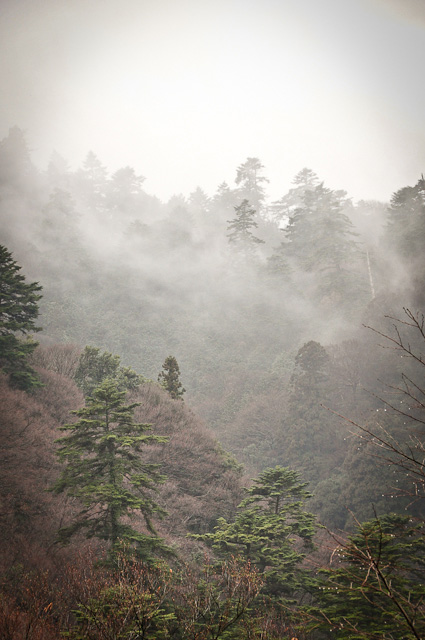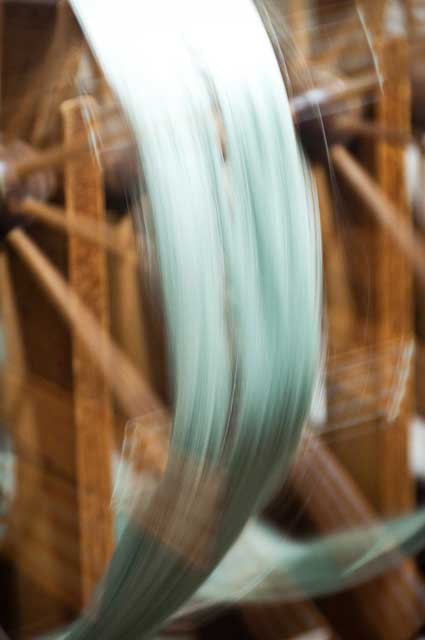Contributed by David Surtasky
Kurozuka (黒塚) (summary)
A fifth category play, author unknown.
 The Buddhist monk Yūkei from the temple in Nachi has decided to make a pilgrimage in the pursuit of alms. He and his companions have made a long and hard journey, so long that even their clothing has been worn to tatters. Passing along by various famous sites, at last they have come far north to Adachigahara. By the time they arrive darkness has covered the land, and the only light visible is in a small hut. The monk and his companions decide to make their way to the hut in order to see if they might spend the night.
The Buddhist monk Yūkei from the temple in Nachi has decided to make a pilgrimage in the pursuit of alms. He and his companions have made a long and hard journey, so long that even their clothing has been worn to tatters. Passing along by various famous sites, at last they have come far north to Adachigahara. By the time they arrive darkness has covered the land, and the only light visible is in a small hut. The monk and his companions decide to make their way to the hut in order to see if they might spend the night.
A middle-aged woman is living in the hut. She speaks of the autumn winds and of her emptiness, loneliness and of the impermanence of life. The monks approach and ask to be let in. From the other side of the brushwood door, the woman refuses, saying that her hut is too modest and that she cannot help them. Begging for mercy, and stating they have nowhere else to turn, the monks ask again. Again the woman refuses pointing out how poor is her lodging, the cracks in her roof and how shabby it is. The monks persist in their request, hoping for just one night’s stay indoors. Eventually the woman relents and opens the door to them.
 Yūkei expresses his thanks for her kindness, and inquires about the woman’s spinning wheel. The woman replies, yes, it is her spinning wheel. The monk asks if the woman would be willing to show them how it is used. The woman feels embarrassed to demonstrate such a humble task before the aesthetic yamabushi, but relents. While spinning hemp threads with her wheel, she reflects on the low status of her birth, and how good it would be if should could only spin time back into the past. Yūkei tells the woman that her life is only temporary and it is everyone’s fate to grow old, and that if she would set her heart on Buddha’s teaching that she would be comforted. Even hearing such words, the woman laments her lost youth with the tears of her desolation.
Yūkei expresses his thanks for her kindness, and inquires about the woman’s spinning wheel. The woman replies, yes, it is her spinning wheel. The monk asks if the woman would be willing to show them how it is used. The woman feels embarrassed to demonstrate such a humble task before the aesthetic yamabushi, but relents. While spinning hemp threads with her wheel, she reflects on the low status of her birth, and how good it would be if should could only spin time back into the past. Yūkei tells the woman that her life is only temporary and it is everyone’s fate to grow old, and that if she would set her heart on Buddha’s teaching that she would be comforted. Even hearing such words, the woman laments her lost youth with the tears of her desolation.
The woman indicates that it is very cold, and so she will go and fetch some firewood to make a fire. She asks the monks to be patient until she returns, and admonishes them not to look in her back room. Yūkei assures her that they will honor her wishes. The woman departs up the darkened path behind her home.
Among the party of monks is a temple servant. He feels suspicious about the woman’s request and inquires of Yūkei whether he might look into the room. The monk refuses him, and reminds the servant of his honorable promise. The servant is consumed by curiosity and waits until the monks fall asleep, and then proceeds to creep quietly into the back room. In horror he discovers the room is filled with the bodies of the dead. Dashing back to Yūkei he wakes him and tells of his shocking discovery.
Yūkei examines the back room. The mound of bodies is apparently without number, limbs askew, corpse upon corpse, piled up to the very roof of the hut. An overwhelming stench fills the air, the rotting flesh swollen and decomposing. In a flash of disturbing realization, Yūkei understands that they’ve come upon the house of the demon of Adachigahara. Terrified by the horrific revelation the monks are panic-stricken.
 The woman returns in her revealed form as the demon of Adachigahara. Ordering the fleeing priests to stop, she shrieks of the revenge she will bring down upon them for breaking their promise. Her furious rage is likened to a burning Chinese palace, the flames and smoke licking the sky for months on end. She flails the air with her iron hammer, chasing the monks with the intent to devour them.
The woman returns in her revealed form as the demon of Adachigahara. Ordering the fleeing priests to stop, she shrieks of the revenge she will bring down upon them for breaking their promise. Her furious rage is likened to a burning Chinese palace, the flames and smoke licking the sky for months on end. She flails the air with her iron hammer, chasing the monks with the intent to devour them.
Intent on saving themselves the priests begin to pray to the five myō-ō, and chanting powerful mantra’s try to stave off the fury of the demon. Yūkei invokes the power of the Buddha calling on Acala (Fudo myō-ō: The Immovable) to bind the demon with his diamond rope. The combined prayers of the monks assault the evil hag. A rising storm rages outside the hut, and the demon regrets that her hiding place has been revealed. Driven back by the powerful prayers, she makes her escape from the torments of the monk’s preaching and disappears into the rain-swept blackness.






